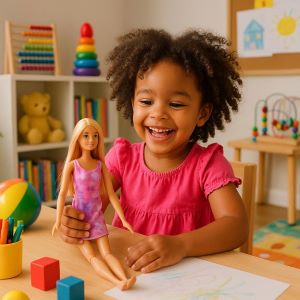The toy world is changing at an unprecedented speed. While until recently, dolls spoke with recorded phrases like "Hello, I'm your friend!", the situation is completely different now. Mattel, the world's largest toy company and creator of the iconic Barbie, has signed an agreement with OpenAI to equip its dolls with artificial intelligence.
This means that future generations of children could converse with toys capable of responding in unique ways, learn from them, and maintain seemingly natural dialogues.
But behind this striking innovation, inevitable questions arise: how will playing with a doll that thinks and responds affect children? Are we witnessing a positive advance or a risk for childhood?
Traditionally, children played with dolls, projecting their inner world onto them. It was the children who invented the questions and also the answers, bringing characters and situations to life that fueled their creativity. This ability to invent is the foundation of symbolic play, essential for emotional and cognitive development.
With a doll that responds thanks to AI, the balance shifts. The child is no longer the sole creator of the dialogue: now the doll provides unexpected responses, setting the course of the interaction. This can limit imagination, as instead of inventing answers, the child becomes accustomed to receiving ready-made ones. And if the voice speaking to them has emotional authority—like that of their favorite doll—they may trust it more than they should.
Proponents of this technology argue that an AI doll can be an educational aid: answering questions, providing companionship in solitude, or fostering curiosity. However, we must not forget that an AI's responses are unpredictable and sometimes inappropriate for a child.

The risk isn't just that the doll might say something inappropriate, but that it might interfere with the construction of a child's emotional world. The child stops exploring their own questions and solutions and instead receives a constant stream of external information. Instead of cultivating the ability to imagine, they might depend on what "the doll" tells them.
And herein lies the great dilemma: do we want a child's emotions and fantasies to be shaped by an algorithm?
Until now, interactive toys had a limited scope: recorded phrases, songs, or simple movements. There was no possibility of adaptation or learning. But artificial intelligence introduces something radically new: the personalization of the experience.
Each child could receive different responses from their doll. Some more innocent, others more complex, depending on how they phrase their questions and how the dialogue evolves. This means that parents won't have complete control over what the toy conveys, and that even the same doll could behave very differently with two different children.
Another important factor is the responsibility of adults. Many parents, fascinated by the novelty, might buy these dolls without giving much thought to their implications. For the company, it will be a profitable business; for children, a social experiment whose effects are still unknown.
Should emotional or behavioral problems arise, blame will likely be placed in the usual places: the school, the teachers, or even the digital platforms themselves. But the initial decision is rarely questioned: was it a good idea to put an AI doll in the hands of a young child?
There's no doubt that, from a market perspective, this partnership between Mattel and OpenAI could be brilliant. Barbie has been reinventing herself for decades, and equipping her with artificial intelligence can give her irresistible appeal in the digital age. However, just because something is a commercial success doesn't necessarily mean it's positive for child development.
AI applied to education can have great advantages, but its application in toys poses a much more delicate issue. Free play, play born from a child's imagination, doesn't need to be guided by an algorithm. On the contrary: it needs space, silence, and freedom to flourish.
The big question is how this trend will evolve. Perhaps in a few years, we'll see dolls that act as personalized tutors, accompanying children in learning languages or math. Or perhaps stricter regulations will be imposed that limit the capabilities of these toys, protecting children's privacy and emotional well-being.
The truth is that we are opening the door to uncharted territory. And like any innovation, it will have its ups and downs. The key will be responsible use: if parents decide to delegate the task of entertaining and educating to the doll, the risk of distortion will be high. If, on the other hand, they are used as a supervised complement, they may be able to add value without damaging the imagination.
The question we should be asking ourselves is not whether we can have AI dolls, but whether we should have them. Childhood is a unique stage where creativity, empathy, and emotional autonomy are built. Altering that process with automated responses may seem like innocent play, but its consequences could be profound.
Technology can be wonderful, but it's not always the best companion for a child. Sometimes, what a girl needs most isn't a doll that talks like an adult, but a silent doll that allows her to invent, imagine, and be the protagonist of her own world.
We'll see what happens quite soon.